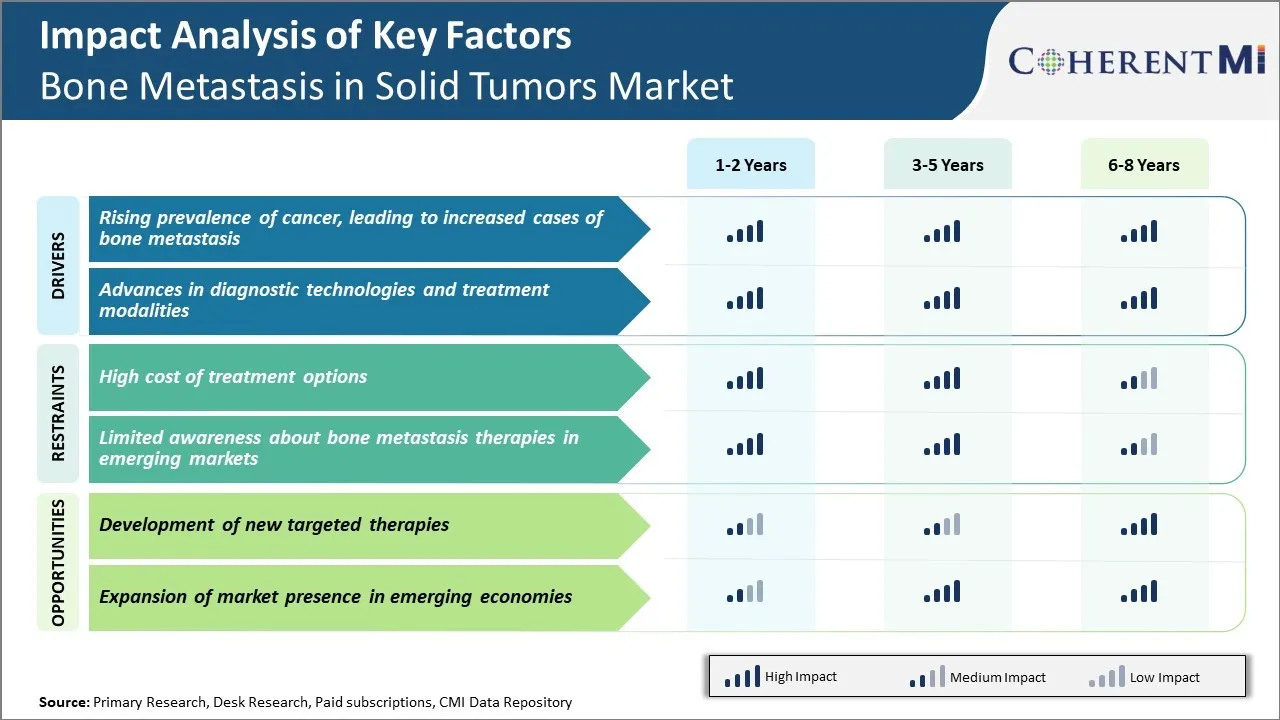Metastasi di ossa nel mercato dei tumori solidi ANALISI DIMENSIONE E QUOTA - TENDENZE DI CRESCITA E PREVISIONI (2024 - 2031)
Bone Metastasis in Solid Tumors Market è segmentato da terapeutica (Bisphosphonates, Immunotherapies, Radiopharmaceuticals), da diagnostica (Imaging, ....
Metastasi di ossa nel mercato dei tumori solidi Tendenze
Driver di mercato - Rising Prevalence of Cancer, con conseguente aumento dei casi di metastasi di ossa
L'aumento dei casi di cancro in tutto il mondo ha portato ad un aumento proporzionale delle metastasi ossee. Aumentare i livelli di obesità legati a diete malsano e la mancanza di attività fisica hanno implicazioni importanti per i tumori come il seno e il colorettale che dimostrano tendenze metastatiche scheletriche.
Poiché l'osso è uno dei siti più comuni per le cellule tumorali da diffondersi da tumori primari situati altrove nel corpo, una maggiore prevalenza di cancro inevitabilmente si traduce in maggiori istanze di questo fenomeno mortale. Mentre i tumori come il seno, il polmone e la prostata hanno a lungo avuto una forte associazione con la metastasi ossea, i dati più recenti mostrano anche alcuni tipi di cancro meno comuni dimostrano una propensione a metastasi allo scheletro.
Nel complesso, gli effetti di compounding di un profilo demografico in espansione e invecchiamento accoppiato con le tendenze sociali circostanti significano diagnosi di cancro primario continuerà a montare. A causa della natura di questa malattia in cui le cellule possono diffondersi dal sito del tumore iniziale, anche i tumori con potenziali di metastasi ossea storicamente più bassi possono manifestare questa complicazione in una frequenza maggiore andare avanti tra le piscine più grandi del paziente. Con le ossa che rappresentano un sito secondario così comune, è intuitivo che i volumi dei casi di metastasi ossea devono anche aumentare proporzionalmente.
Driver di mercato - Avanzate nelle tecnologie diagnostiche e nelle modalità di trattamento
Sono stati compiuti notevoli progressi nello sviluppo di metodi altamente sensibili e specifici per rilevare la presenza e l'estensione delle metastasi ossee. Le tecnologie avanzate di imaging come le scansioni in PET e la risonanza magnetica a corpo intero consentono l'identificazione precoce e più accurata dei siti coinvolti rispetto alle modalità tradizionali. Allo stesso modo, i nuovi test biomarcatori stanno migliorando le capacità di monitorare la progressione della malattia o la ricorrenza in modo minimo invasivo.
Le terapie sistemiche moderne offrono anche opzioni ampliate per interferire con la patobiologia delle metastasi ossee. Le varianti migliorate dei bifosfonati e degli inibitori della lega RANK offrono una maggiore protezione scheletrica contro le complicazioni. Inoltre, un portafoglio diversificato di farmaci molecolati, immunoterapie e altri nuovi agenti offre opportunità di non solo palliare il dolore, ma anche potenzialmente limitare la crescita e la diffusione del tumore.
Accanto agli interventi farmacologici, le tecniche a guida d'immagine minimamente invasiva consentono la consegna mirata del trattamento. Le opzioni includono radioterapia, crioterapia, vertebroplastica e kyphoplasty.
Con la continua raffinazione terapeutica e l'espansione dell'esperienza clinica, i protocolli di gestione della metastasi ossea stanno diventando sempre più ottimizzati. Questo stimola la domanda per i vari strumenti diagnostici, farmaci e procedure applicabili attraverso il continuum della malattia dall'identificazione precoce alla gestione a lungo termine. Il loro impatto cumulativo spinge la crescita della metastasi ossea complessiva nel mercato dei tumori solidi.

Sfida di mercato - Alto costo delle opzioni di trattamento
La metastasi ossea nel mercato dei tumori solidi affronta sfide significative nell'alto costo delle opzioni di trattamento disponibili. Gli approcci di trattamento attuali come la chemioterapia, la radioterapia e le terapie di supporto come i farmaci di gestione del dolore spesso richiedono un uso a lungo termine per gestire efficacemente i sintomi complessi delle metastasi ossee. Questo onere di trattamento a lungo termine porta a costi sostanziali non solo per i sistemi sanitari e i paganti, ma anche i costi fuori borsa per i pazienti.
La natura avanzata dei tumori ossei metastatici significa anche che i pazienti hanno generalmente esaurito le terapie iniziali peggiorando le loro condizioni e aumentando i costi di trattamento. Inoltre, la mancanza di opzioni curative richiede cure palliative e trattamenti di supporto per periodi prolungati che aumentano i costi.
Inoltre, molti pazienti di metastasi ossea sono anziani che sono spesso su redditi fissi, rendendo difficile per loro di offrire elevate spese di trattamento. L'alta barriera per accedere a terapie efficaci pone una grande barriera alla qualità della vita e risultati clinici per i pazienti affetti da metastasi ossea.
Opportunità di mercato - Sviluppo di nuove terapie mirate
La continua ricerca attiva e sviluppo di nuove terapie mirate rappresenta una grande opportunità per guidare progressi nella metastasi ossea nel mercato dei tumori solidi. Recenti miglioramenti nella comprensione dei meccanismi molecolari sottostanti metastasi ossea hanno aperto le porte per mirare più precisamente a percorsi e processi chiave coinvolti.
Diverse aziende biofarmaceutiche stanno conducendo studi clinici per nuovi agenti mirati a proteine come DLL4, NRP2, PD-1 e TGF-β tra gli altri che svolgono ruoli nella formazione di metastasi ossee. Lo sviluppo di terapie mirate efficaci e ben tollerate può trasformare gli approcci di trattamento offrendo risultati superiori rispetto alle opzioni tradizionali come la chemioterapia.
Le nuove opzioni mirate promettono anche paradigmi di trattamento più convenienti e personalizzati come precisa profilazione molecolare aiutano a abbinare i pazienti giusti agli agenti mirati più adatti. Questo andrà a lungo nell'affrontare l'attuale sfida di mercato di elevati costi di cura. Inoltre, le terapie mirate sono previste per dimostrare un miglioramento dei profili di sicurezza sui farmaci citotossici convenzionali, migliorando la qualità della vita dei pazienti.